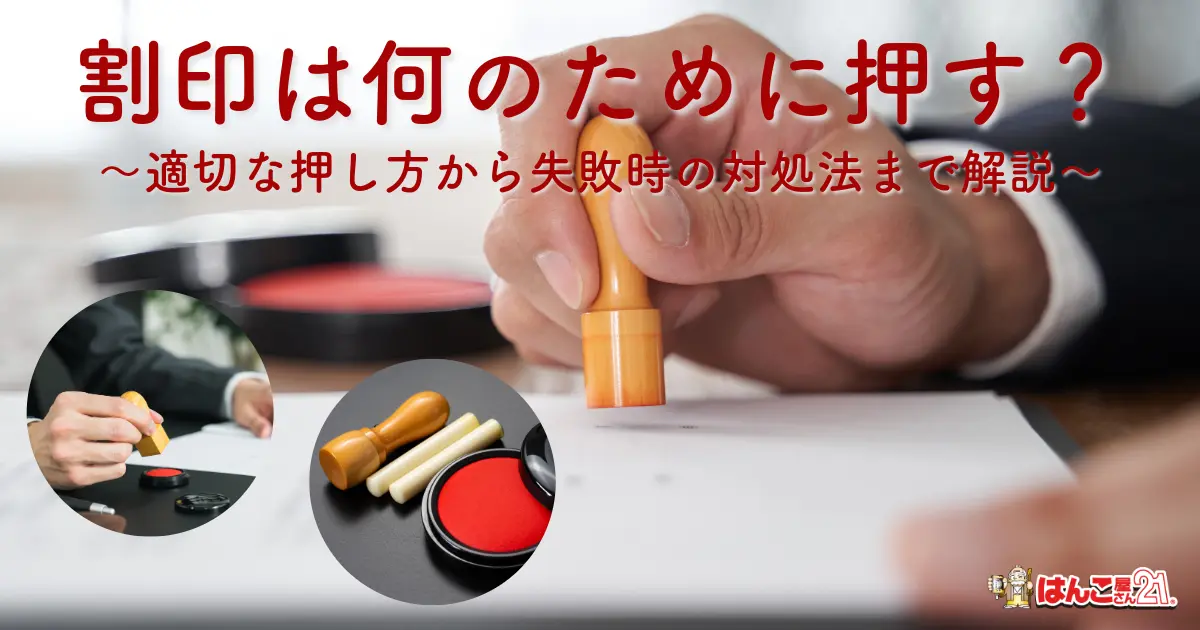Have you ever heard the term "wari-in" when stamping a HANKO on a contract or other document?
A split seal, as the name suggests, is a seal that is split, and is typically used on two or more documents. However, as this is a method of stamping that not many people are familiar with, some people may not know how to use it. If you don't know how to use a split seal, you'll be in trouble when you actually need one. In this article, we'll introduce you to split seals. Take this opportunity to learn everything from the meaning of split seals to the proper way to use them.
- A split seal is used to prove that documents are related or that their contents are the same.
- Differences between wariin and similar words
- Rules for stamps and how to stamp them
- Steps for stamping neatly
- The proper way to stamp three or more documents
- If you use multiple stamps often, it is convenient to have a special stamp made for you.
- Three things you should know about splitting stamps
- summary
A split seal is used to prove that documents are related or that their contents are the same.
A split seal has the effect of proving that documents are related and that their contents are the same. This certifies that documents can be prevented from being tampered with or copied.
Generally, a contract is prepared for each party to the contract. In most cases, when there are two or more parties and two or more copies of a document are prepared, a split seal is used to prove that the contents are the same. Each contracting party receives one copy of the split seal contract.
In addition to contracts, there are also cases where you will need to stamp receipts and copies.
Differences between wariin and similar words

The words listed below are similar to wari-in but strictly speaking have different meanings.
- Stamp
- Seal
- Contract seal
- postmark
- correction mark
- stamp
- Stamp
We will explain each one in detail.
Stamp
A seal refers to the act of pressing a stamp. A wari-in is also an act of pressing a stamp, so it fits the meaning of a seal, but the act of pressing a stamp itself is called a seal, regardless of the type of seal, such as a contract seal or a contract seal.
Seal
A seal is a seal that is applied to a contract or other document that has multiple pages, with the seal leaving an impression across each page. By showing the continuity of the pages, it is effective in preventing the document from being stolen or replaced.
Contract seal
A contract seal is a stamp that is placed after the signatures of the parties at the end of a contract, and is generally stamped with the seal of the contract holder.
A contract seal shows that the seal was made based on the will of the parties and has the effect of proving that the document has been properly established. When stamping, it does not matter whether the seal is placed over the signature or placed away from the signature.
postmark
A postmark is a stamp that is pressed across the stamp and the contract when attaching a revenue stamp. It is also treated as a postmark when it is pressed across the postage stamp and the mail piece. It also has the effect of indicating that the postage stamp or revenue stamp has been used, preventing it from being reused.
correction mark
A correction seal is a seal used to correct or amend the contents of a document when there is an error in the text. It shows that the correction was made by the person who created the document and has the effect of proving that it has not been tampered with.
stamp
A discarded seal is a mark that is pressed in the margin of a document in advance and can be used as a correction seal when a mistake is found. In addition, by writing the correction details of the document next to the discarded seal, it has the effect of proving that the correction has been made.
Stamp
A stop seal is a seal that is placed at the end of a document when there is a blank space at the end of the document to prove that the sentence has ended at that point. Therefore, even if any content is added after the stop seal, the added content becomes invalid, preventing unintended additions by the document creator.
Since affixing a stop seal is not mandatory, it is not uncommon for the stop seal to be omitted when creating documents.
Rules for stamps and how to stamp them

Below are the rules you need to know regarding the stamps used for split seals and how to press them.
- There are no legal rules on how to stamp a document.
- It is common to use the seal of the signature for the cross-signing.
- The place where the seal is affixed varies depending on the document.
We will explain each one in detail.
There are no legal rules on how to stamp a document.
There are no legal rules for how to stamp a document. This is because as long as a stamp is stamped on all documents that need to be stamped, it will function properly.
However, if you stamp haphazardly, it may result in not stamping all of the document, so to be on the safe side, stamp according to practical practice.
It is common to use the seal of the signature for the cross-signing.
Generally, the stamp used for the signature is used for the split seal. There are almost no cases where different stamps are used for the signature and split seal, so the same stamp is generally used.
However, depending on the number of documents, it may be difficult to stamp all of them at once. If there are many documents, a vertical stamp specially designed for stamping may be used.
The place where the seal is affixed varies depending on the document.
The place where the seal is stamped varies depending on the document as follows:
| document | Place to stamp |
| contract | Place two documents together, slightly offset, and stamp where they overlap. |
| receipt | Place the original and the copy slightly apart and affix a seal where they overlap. |
| Revenue stamp (postmark) | The stamp or signature must be stamped or signed in one of the following ways so that it will be applied to both the tax document and the stamp.
|
For contracts and receipts, it is common to stamp it on the top or side of the document.
When affixing a revenue stamp to a document subject to stamp tax, a postmark is required in accordance with the Stamp Tax Act. Specifically, a designated person must affix a seal or signature so that the stamp's postmark is on both the document and the document subject to stamp tax.
Steps for stamping neatly
The steps to stamp neatly are as follows:
- Check the place to stamp
- Place the document on the stamp mat
- Be careful to apply the ink evenly to the stamp.
- Hold the stamp correctly
- Hold the stamp vertically
- Use a pressure that is neither too strong nor too weak.
- Slowly remove the stamp from the document
- Wipe off the red ink from the stamp
- If the seal fails, try again in a different place.
We will explain each one in detail.
1. Check the place to put the seal
First, let's check where to stamp. For a contract and a receipt, stack the two documents slightly offset from each other and stamp the top or side. When stamping a revenue stamp, make sure to stamp it so that it covers both the taxable document and the stamp's colored pattern.
2. Place the document on the stamp mat
Once you have confirmed the location of the stamp, place the document on the stamp mat. You can stamp it without a stamp mat, but it will be easier to stamp evenly if you have one.
3. Be careful to apply the ink evenly to the stamp.
When applying vermilion ink to a stamp, be sure to apply it evenly. If the ink is applied unevenly, the seal may chip or be unevenly printed. Hold the stamp perpendicular to the ink pad, and apply the ink evenly.
4. Hold the stamp correctly
To crease a seal properly, it is important to hold the seal correctly. You can hold the seal correctly by keeping the following in mind.
| finger | How to serve |
| index finger | Place it directly above the characters on the seal. |
| thumb | Place the pad of your finger on the stamp |
| middle finger | Place the side of your finger on the stamp |
It is a good idea to remember the above holding method as it will be useful for other stamping as well.
5. Hold the stamp vertically
Once you've got the stamp in the right position, hold it perpendicular to the document. This will make it easier to apply pressure evenly and ensure a neat stamp.
6. Use a pressure that is neither too strong nor too weak to make the seal.
Make sure to use a pressure that is neither too strong nor too weak when applying the seal. If you apply too much pressure, the seal will be easily crushed, and if you apply too little pressure, the seal will be faint, so be careful. If the document is placed properly and you hold the seal correctly, you can apply a clean seal with just a little pressure.
7. Slowly remove the stamp from the document
Once you have stamped the document, slowly remove the stamp from the document. If you do it incorrectly, the ink may bleed. The trick is to hold the document firmly in your hand and slowly remove the stamp in a straight upward direction.
8. Wipe off the red ink from the stamp
Once you have finished stamping the seal, wipe off the red ink on the stamp. If the red ink is left on the stamp, it will dry out and may become chipped or damaged. Gently wipe off the red ink with a cloth or tissue and store the stamp in its case.
9. If the seal fails, try again in a different place.
If you make a mistake when stamping, such as bleeding or smudging, press it again in a different place. There is no need to take any action such as making corrections to a failed stamp. In order to prevent a second mistake, be sure to keep the above steps in mind when stamping.
The proper way to stamp three or more documents
When stamping three or more documents, the proper way to do so is as follows:
- Use a stamp made specifically for splitting to stamp vertically.
- Stamp two copies at a time
We will explain each one in detail.
Use a stamp made specifically for splitting to stamp vertically.
When stamping three or more documents, it is easier to use a stamp specifically designed for stamping. Stamps specifically designed for stamping are oblong in shape, and even if there are multiple documents, the stamping can be completed with a single stamp.
Also, it doesn't matter if the stamp used for the split seal is different from the one used for signing the contract. Therefore, even if you use a regular stamp for the contract, you can use a stamp specifically for split seals for other documents.
Stamp two copies at a time
If you don't have a stamp specifically for splitting, you can split two copies with a HANKO that you would use to stamp a contract, such as a corporate seal. For example, if you have three documents, A, B, and C, you can split the seals as follows:
- Place documents A and B on top of each other and stamp them.
- Place documents B and C on top of each other and stamp them.
If the document is four or more pages, please stamp each copy in duplicate as above.
Three things you should know about splitting stamps
There are three things you need to know about stamps:
- There is a designated person who should stamp the letter.
- A contract is valid even without a seal
- If you want to avoid the hassle of signing a contract, we recommend an electronic contract.
We will explain each one in detail.
There is a designated person who should stamp the letter.
The people who should affix a postmark are determined by Article 5 of the Stamp Tax Act Enforcement Order as follows:
- Member
- The individual's representative (including the representative of a corporation)
- Servant
- Other employees
Taxable documents prepared by multiple parties only require that any one of the parties stamp the document. The reason it is not necessary for all parties to stamp the document is because the postmark indicates that the document has been used and cannot be reused.
A contract is valid even without a seal
A contract can be valid even without a split seal. This is because the method of concluding a contract is free and split seals are not required.
However, split seals have the effect of preventing contract tampering. Basically, split seals should only be used when the contents of the documents are the same. In other words, if the contents of two contracts with split seals are different, it is highly likely that one of the documents has been tampered with.
For example, let's say that in a lawsuit resulting from a contract dispute, the other party presents a contract that is likely to have been falsified. In contrast, if you present an invoice with the same content but with a stamp, this will have more evidentiary weight because the possibility of falsification is close to zero.
A split seal is not necessary on a contract, but it is safer to stamp it just in case of any contractual disputes.
If you want to avoid the hassle of signing a contract, we recommend an electronic contract.
If you want to avoid the trouble of stamping, we recommend electronic contracts. An electronic contract is a contract method that is concluded over the Internet without using any paper. Electronic contracts use electronic signatures, so there is no need to stamp the document.
An electronic signature is a signature that guarantees the authenticity of the person and that the contents have not been tampered with. Electronic signatures, which are considered electronic signatures, strictly guarantee authenticity and non-tampering using the following technologies.
- Public Key Cryptography
- Public Key Infrastructure
- Hash Functions
The advantage of electronic contracts is that you don't need to prepare a special seal and you can easily sign online. Another advantage is that you can conclude contracts without using paper, which contributes to a paperless society.
summary
A split seal is a seal used to prove that documents are related or that their contents are the same. A contract can be valid without a split seal, but it can be used as evidence in the event of a contract dispute, so it is best to have one just in case.
There are no legal rules regarding stamps or how to stamp a wari-in, so you don't need to think too hard about it. However, if you make a mistake in stamping, you will need to stamp it again, so be careful not to lose any parts or smudges in the seal.
 日本語
日本語 English
English 简体中文
简体中文 繁體中文
繁體中文 한국어
한국어 ไทย
ไทย Tiếng Việt
Tiếng Việt Indonesia
Indonesia Français
Français Español
Español Português
Português


